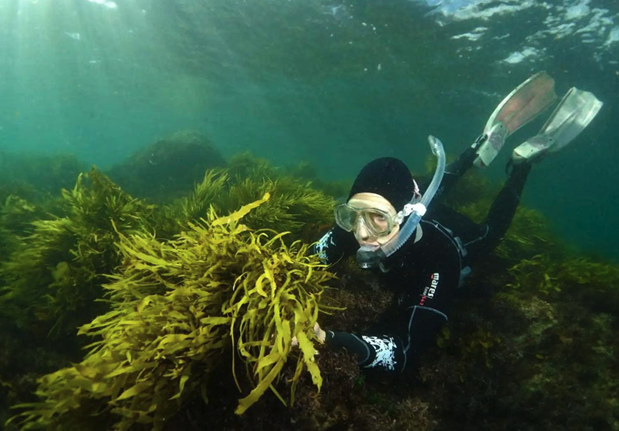Picture this: You plunge beneath the waves and find yourself in an underwater Eden. Towering kelp fronds sway like ancient trees, sunlight flickering through their emerald canopy. This is no ordinary seaweed—it's a living, breathing metropolis of marine life, and it's vanishing before our eyes.
Credit: Kelp Forest Alliance
Kelp 101: The Ocean's Unsung Superhero
Kelp isn't just algae—it's a master of survival. Anchored by grip-like holdfasts (not roots!), stretching skyward with stem-like stipes, and sprouting leafy blades, these giants can grow up to 60cm a day—reaching heights rivaling a 10-story building.
And they're not picky tenants: From California's icy Pacific to Australia's rugged coasts, kelp forests thrive—even surprising scientists in 2007 by sprouting near Ecuador, challenging the notion that they exist only in cooler regions.
Why Kelp Forests Matter (To You, Too)
Think of kelp as the ocean's Swiss Army knife:
- A Biodiversity Hotspot: Home to otters that wrap themselves in kelp to stay anchored while resting, fish, and crustaceans, it's the Times Square of marine life. In fact, kelp forests harbor a greater variety and higher diversity of plants and animals than almost any other ocean community; busier than coral reefs in some areas.
- A Climate Warrior: Kelp slurps CO₂ faster than terrestrial forests, locking carbon away in the deep sea.
- A Coastal Shield: Its tangled fronds break waves, shielding shorelines from storms and preventing erosion.
- A Pantry for People: Kelp is also harvested for various products, including sushi wraps to cosmetics, fertilizers—kelp fuels industries worth billions.
The Silent Crisis Beneath the Waves
Despite their resilience and giving nature, kelp forests face numerous threats. Warming oceans starve kelp of nutrients. Overfishing disrupts the balance of the ecosystem, allowing herbivores like sea urchins to proliferate and overgraze kelp stands. Pollution and coastal development further degrade these habitats, making conservation efforts critical.
Recognizing the importance of kelp forests, various initiatives are underway to protect and restore them. For instance, in Tasmania, marine scientists have launched a $3.5 million project to restore giant kelp forests by collaborating with local industries and communities. This project involves rearing and planting kelp, removing competing seaweed species, and rebuilding populations of natural predators like rock lobsters to control herbivore numbers.
Kelp Forests— How You Can Help
Kelp forests teach us a vital lesson: resilience through interconnectedness. Much like these ecosystems, the path to a sustainable future requires collaboration across industries, from scientists to athletes, from fans to business leaders.
The Kelp Forest Alliance (KFA) leads the charge with the Kelp Forest Challenge: a global mission restore 1 million hectares and protect 3 million hectares of kelp forest habitat by the year 2040.
Final Lap
Kelp forests are Earth's silent life-support system. They feed coastlines, fight climate change, and foster wonders we've barely explored. So next time you see the ocean, remember: beneath those waves lies a world worth protecting—and it's a race we can't afford to lose.
